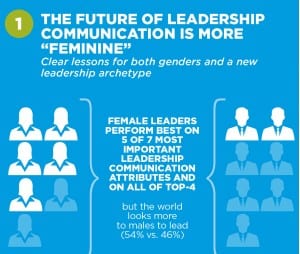 As Seen in The World Economic Forum’s Blog…
As Seen in The World Economic Forum’s Blog…
Picture the scene: It’s your annual appraisal and your boss has said she wants the discussion to focus mainly on your leadership. She opens by telling you that just over one in five of your colleagues actually think you’re a good leader (ouch). She goes on to say that only a third believe you lead based on clear values. And that a touch more than one in ten think you take proper responsibility when things go wrong (eek). Not a good day at the office so far.
What’s more, you learn that, being a man, your female counterparts outshine you on almost every characteristic your colleagues look for in a good leader – even though they oddly expect you, as a man, to be better. She concludes by stressing that as a communicator, there is a yawning gap between what is expected of you and your delivery against those expectations. Perhaps now isn’t the time to ask for that pay rise or promotion after all!
Sadly, this isn’t a gruesome fantasy. Rather, this is precisely the verdict being passed down by the public – 6,509 people in 13 countries on five continents – on today’s leaders across business, politics, non-profits, labour unions and communities. That’s according to a global study, the Ketchum Leadership Communication Monitor (KLCM), which for three years has helped analyse the relationship between leadership and communication. This research is echoed in the Forum’s own Global Agenda Outlook work, which also reveals the extent of the global leadership crisis.
As leaders around the world seek to tackle this crisis, the point it highlights about gender and leadership merits particular attention. The Forum’s latest annual Gender Gap Report shows the particularly stubborn persistence of gender inequality in the workplace. Indeed, the report finds that the gender gap for “economic participation and opportunity” now stands at 60% worldwide, and that, based on this trajectory, with all else remaining equal, it will take 81 years for the world to close this gap completely.
Depressing stuff when looked at alongside the overall leadership crisis. Well, possibly, but I’d also argue that there is a sliver of light that might lead us to be a little more optimistic.
To explain, our KLCM work reveals that, for whatever reason, the world is still looking marginally more to men than women to lead over the next five years – 54% to 46%. And yet those same respondents see female leaders as outperforming their male counterparts on pretty much every single attribute found by the research to be important to effective leadership. More specifically, female leaders “win” over male colleagues on all but four of the 14 attributes we explored. This has led us to conclude that the future of leadership communication is more “feminine”.
So, if we are looking for reasons to be cheerful – when faced with a wall of data pointing to a persistent crisis of leadership and gender parity – I would argue that this female outperformance on what the world believes really matters suggests that the 81-year timescale could be a little pessimistic.
Let me be very clear here that none of this is – or should ever be – about the inherent superiority of either gender over the other. After all, parity presupposes equality. There could be nothing more damaging to this debate than allowing the very discrimination we seek to banish replaced by a form of reverse prejudice.
Indeed, if we are to help move this utterly critical discussion on gender and leadership forward in a way that will drive positive outcomes for all involved, it must be by heeding the practical lessons from leaders of both genders.
We may find ourselves in the midst of a global crisis of leadership and enduring gender inequality. But the solutions may be closer than we think, if leaders of all kinds – and of both genders – are willing to learn from the leadership behaviours currently being demonstrated rather better by Eve than by Adam.
So to close, here are some lessons highlighted by the KLCM:
1. Leaders’ actions, not just their words, show what the organization values. “Leading by example” tops the list of key leadership attributes, immediately followed by “communicating in an open and transparent way” – underlining the critical importance of avoiding pernicious “say-do” gaps.
2. Transparency is non-negotiable. Provide it voluntarily to build trust or it will be imposed on you, whether you like it or not.
3. Chart a visible course for continuously making the future better. Make no mistake – amid all of today’s pressures and challenges, the world still seeks leaders capable of showing clear, decisive vision.
4. Admit mistakes, solve problems and move forward. As much as we continue to crave strong, visionary leaders, the willingness to admit mistakes is the third most important leadership attribute and a mark of strength, not weakness – as long as it is backed up by decisive action.
5. Collaborate and bring others to the table to solve problems. The top “emerging” leadership attribute is the ability to build and inspire teams who will create the future – underlining the role of the leader as empowering facilitator, rather than know-it-all autocrat.
6. Treat your employees as you would like your brand or organization to be treated. The most powerful leadership starts inside the organization – something leaders ignore at their peril.


